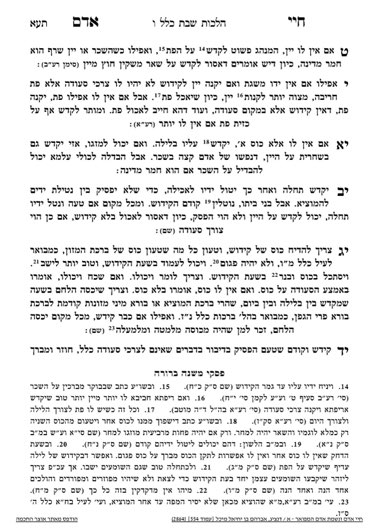The current series, which will cover Maariv on Friday night and Kiddush, is available for sponsorship. Please contact Rabbi Reingold for more information.
We are continuing in siman 13, where we have learned the halachos regarding the kos. Today, we will discuss the recitation of kiddush.
The Chayei Adam writes that one may stand when reciting kiddush, but it is more appropriate to sit. If one is being motzi others, when it comes to brachos, Chazal set up that whatever is being done must be done as a unit, so that the motzi and yotzei are sharing, so to say. When there is a kvius (a fixed representation), as there is by a seudah, they are clearly sharing in the process. In the Gemara, this process of kvius was represented by reclining together. Thus, both the motzi and those being yotzei should be seated, to best demonstrate this kvius. However, it is not meakeiv, as long as they are not milling around while the motzi is making kiddush. Similarly, when it comes to a shul kiddush, the person reciting kiddush is only motzi the people who are standing still or sitting, not those moving around. Nevertheless, it is still preferable that they sit.
There is a halacha that one should look at the kos shel bracha when making a bracha. The purpose is to avoid a hesech hadaas from the kos shel bracha.
Regarding looking at the neiros, it is brought in kabbalistic sources that one should look at the candles at the time of kiddush, because it restores the eyesight of a person which was lost during the week. Although the kabbalistic sources hold one should look at the neiros for the entirety of kiddush, some will look at the neiros before kiddush, and then begin kiddush and look at the siddur or kos.
Although it is brought down to specifically look at the neiros during vayechulu, there is a strong reason to look in the siddur. We have a concept that devarim shebichsav ee ata rashai l’lomdam b’peh, that anything related to Torah shebichsav should be transmitted through writing, and anything related to Torah shebaal peh should be spoken orally. We now write Torah shebichsav, because Rav Yehuda HaNassi understood that we would otherwise forget it. The Gemara explains that he did this based on a pasuk in Tehillim, that eis la’asos lashem, he’feiru torasecha, that it was necessary to act because the Torah was being forgotten.
Within this concept of not reciting devarim shebichsav baal peh, there are many tefillos which we recite which are from Tehillim or the like, and we are not makpid to read them from a siddur. The Gra explains that one may recite these tefillos baal peh as long as they are alone, but if they are being motzi another, they cannot recite it from memory.
We have learned that one of the reasons for rectiing vayechulu is to be motzi family members. If so, the halacha about reading devarim shebichsav from a text applies to vayechulu, and explains why some look into the siddur rather than at the neiros. On the other hand, the Chayei Adam had a different suggestion as to why we recite a second vayechulu, and one could still look at the neiros according to him.
The Chayei Adam writes that one must begin kiddush with vayechulu. If a person recited the regular kiddush without vayechulu, they can recite it later, preferably over a cup of wine even during the meal. if they are unable to find more wine, they would recite it without wine.
Summary
- It is most appropriate to sit for kiddush, although one may stand in place as well.
- The halacha is to look at the kos shel bracha when reciting kiddush
- During Vayechulu, one should look at the neiros.
- Some look at the beginning of vayechulu, and in the siddur for the rest. Some look at the neiros for the whole duration of vayechulu.



